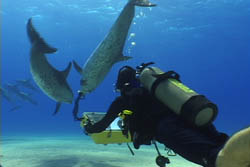
Photo of dolphin meat by Dr. Carlos Yaipen Llanos
By Dr. Carlos Yaipen-Llanos reporting to BlueVoice
I just returned last night from the stranding site. Several key findings. I traveled with the personnel of Reuters International (Press Agency) and it is going to be a press release tomorrow. I am on the paperwork for a denounce (report) to the Ecological Police of Peru too. Despite it was a one-day-round trip, it was enough to assess the situation. I will try to describe in detail our findings. Definitively, we have to go back because too many lives (both human and animals) are at stake.
1. The species affected are not bottlenose dolphins as depicted in the media, but Long beaked common dolphins (Delphinus capensis). We found adult males, females, pregnant females, juveniles and calves.
2. There were not 260+ stranded dolphins. In our survey over 100 Kms between San Jose and Morrope in Lambayeque State, we just found 17 dolphins.
3. A pod of over 150 Delphinus capensis was sighted during the survey, surfacing and feeding in coastal waters, 150+ meters inshore. So, it is a fact that the dolphins LIVE in the area and it is critical for their
breeding behaviour, that will justify the high presence of babies.
4. The stranding started last Thrusday (Feb 9th). However, at 5pm on the 11th, a juvenile dolphin stranded right in front of us (there is an online
picture of the dolphin with blood by the ear-eye).
5. I don't think this mass stranding is related to the earthquakes as stated in some media for two reasons:
a. The Delphinus capensis migrate from Costa Rica to the Central Pacific to northern Peru, to far away from the epicenter of any of the latest earthquakes (around 1000 km difference).
b. Since there are not 200+ stranded dolphins, the problematic is more "focalized" to a local issue.
6. There were no fish of any kind stranded sea animal next to the dolphins. Anchovies were reported floating in the water last week by the media and govenrment officials, but we found no evidence of fish species being affected at this point. Fishermen were fishing flying fish in the area with no problem.
7. As far as we know, the Imarpe (Institute for the Sea of Peru) took samples for analysis. However, in our survey no dolphin showed signs of necropsy or sample collection, just slaughtering from fishermen. I always
check this in the animals to have a bigger picture of what the authorities are looking for (and if they have any clue at all).
8. There was no evidence of carcass collection in 100 kms long, including within the town of San Jose were fishermen and children are in the beach covered of trash and the carcasses of death dolphins (most of them
slaughtered). There was also no evidence of ocean tide removing carcasses because we found several dolphins located far into the high tide, there since last Thrusday.
9. As you know, in January 21st this year, a previous survey performed in Colan, Piura State (300Km north of San Jose). We assessed nine baby common dolphins and a new born porpoise with acute gastric syndrome and signs of immune-suppression / toxicity, but next to them, hundreds of fish corresponding to both bentic species such as morena fish, clams and needle fish, and pelagic fish like anchovies...fish species that match the living sustrate of the common dolphin and the black porpoise. We also found large stains of oil compounds in water and sand by that time for our diagnose
was bio-accumulation under the frame of some sort of hydrocarbon flux to the sea in that area. Basically, long term pollution exposure.
10. In previous survey we collected samples of a baby porpoise for histopathology. In this survey, we collected samples from the juvenile common dolphin: Periotic bones and main organs. This dolphin was
immune-suppressed, since it has a severe infection, abscesses and signs of pox in the skin. I also sampled key tissues to discard the potential presence of viral diseases such as distemper through histopathology. I
certainly believe the common dolphin pods are suffering of long-term pollution exposition, leading them towards immune suppression symdromes that will be more evident in the forthcoming years.
11. Now Hardy, what we found in this mass stranding is that 10 of the 17 animals found dead had broken periotic bones, that is, due to acoustic impact. The source of the impact was from the right side of the pod, since hemorragic internal ear was found in the right side of the stranded animals.
12. We know that the use of dynamite is common among fishermen, and that fishermen are taking the meat of the stranded dolphins. This could be the cause of death of the animals...however, the signs do not correspond to that of explosive impact in their bodies. We talked today with people from the oil company and they say they haven't performed any seismic exploration in the area this month. However, here in Peru these companies
doesn't need to do the seismic assessment themselves.
13. ORCA has a wide registration of dolphin slaughtering in San Jose, as well as dolphin meat consumption and a high incidence of diabetes among
the human population that has dolphin meat in its diet.
It is our next step to go back to San Jose and vecinities to collect more information and samples for the pollution assessment. We can save it in
storage until the equipment is available. This is critical for both animal and human health.
Hope you find this information helpful.
Abraco,
Carlos.
**************************
Dr. Carlos Yaipen-LLanos
President - Science Director
ORCA
Organization for Research and Conservation of Aquatic Animals
Youtube: www.youtube.com/ORCAPERU
Facebook: Orca Peru

